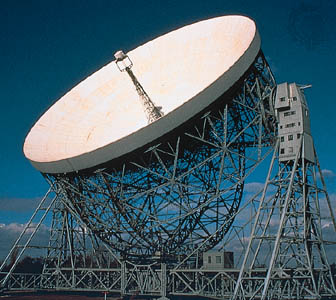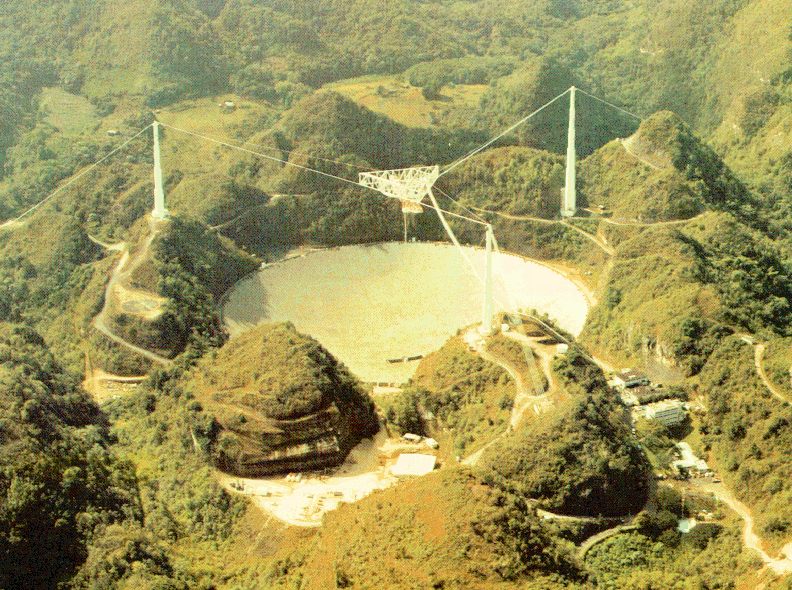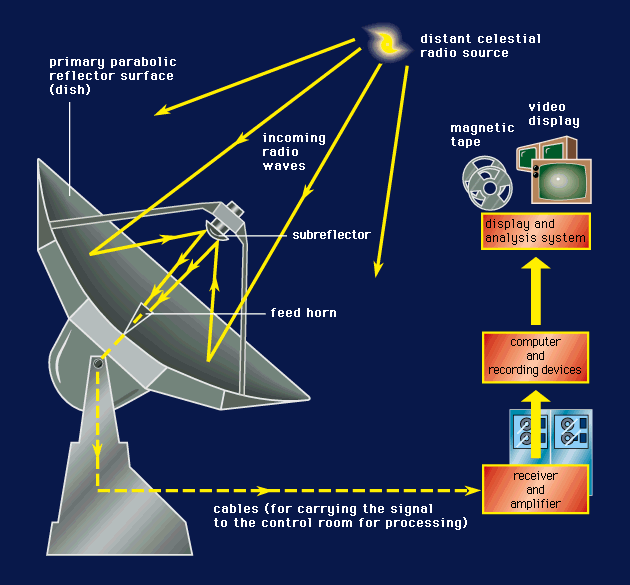
Radio telescope is an astronomical instrument consisting of a radio receiver and an antenna system that is used to detect radio-frequency radiation emitted by extraterrestrial sources. Because radio wavelengths are much longer than those of visible light, radio telescopes must be very large in order to attain the resolution of optical telescopes.

The first radio telescope, built in 1937 by Grote Reber of Wheaton, Ill., U.S., was a steerable paraboloid--i.e., a device with a parabolically shaped reflector, dubbed the "dish," that focuses the incoming radio waves onto a small pickup antenna, or "feed." The radio telescope at Jodrell Bank, Cheshire, Eng., has a steerable paraboloid antenna 76 m (250 feet) in diameter (see photo above). The reflecting surface of the telescope at Arecibo, P.R., fills a naturally occurring bowl-shaped depression 305 m (1,000 feet) in diameter. The Arecibo installation is equipped with a radar transmitter for the study of radar signals reflected from such celestial objects as planets and their satellites (see photo below).

Radio telescopes vary widely, but they all have two basic components: (1) a large radio antenna and (2) a radiometer or radio receiver. The sensitivity of a radio telescope--i.e., the ability to measure weak sources of radio emission--depends on the area and efficiency of the antenna, the sensitivity of the radio receiver used to amplify and detect the signals, and the duration of the observation. For broadband continuum emission the sensitivity also depends on the receiver bandwidth. Because some astronomical radio sources are extremely weak, radio telescopes are usually very large and only the most sensitive radio receivers are used. Moreover, weak cosmic signals can be easily masked by terrestrial radio interference, and great effort is taken to protect radio telescopes from man-made interference.
The most familiar type of radio telescope is the radio reflector consisting of a parabolic antenna--the so-called dish--which operates in the same manner as a television-satellite receiving antenna to focus the incoming radiation onto a small antenna referred to as the feed, a term that originated with antennas used for radar transmissions (see figure below). In a radio telescope the feed is typically a waveguide horn and is connected to a sensitive radio receiver. Cryogenically cooled solid-state amplifiers with very low internal noise are used to obtain the best possible sensitivity.

Observing times up to many hours are expended and sophisticated signal-processing techniques are used to detect astronomical radio signals that are as much as one million times weaker than the noise generated in the receiver. Signal-processing and analysis are usually done in a digital computer. Although some of the computations may be carried out by microcomputers (i.e., those of the personal-computer class), other tasks require large, high-speed machines to translate the raw data into a form useful to the astronomer.
The performance of a radio telescope is limited by various factors: the accuracy of a reflecting surface that may depart from the ideal shape because of manufacturing irregularities; the effect of wind load; thermal deformations that cause differential expansion and contraction; and deflections due to changes in gravitational forces as the antenna is pointed to different parts of the sky. Departures from a perfect parabolic surface become important when they are a few percent or more of the wavelength of operation. Since small structures can be built with greater precision than larger ones, radio telescopes designed for operation at millimetre wavelength are typically only a few tens of metres across, whereas those designed for operation at centimetre wavelengths range up to 100 metres in diameter.
Some radio telescopes, particularly those designed for operation at very short wavelengths, are placed in protective radomes that can nearly eliminate the effect of both wind loading and temperature differences throughout the structure. Special materials that exhibit very low absorption and reflection of radio waves have been developed for such structures, but the cost of enclosing a large antenna in a suitable temperature-controlled radome may be almost as much as the cost of the movable antenna itself.
Radio telescopes are used to measure broad-bandwidth continuum radiation as well as spectroscopic features due to atomic and molecular lines found in the radio spectrum of astronomical objects. In early radio telescopes, spectroscopic observations were made by tuning a receiver across a sufficiently large frequency range to cover the various frequencies of interest. This procedure, however, was extremely time-consuming and greatly restricted observations. Modern radio telescopes observe simultaneously at a large number of frequencies by dividing the signals up into as many as several thousand separate frequency channels that may range over a total bandwidth of tens to hundreds of megahertz.
Radio interferometers consist of two or more widely separated antennas connected by transmission lines. With their greatly increased resolving power, they can be used to determine the position or diameter of a radio source or to separate two closely spaced sources. Phase-array telescopes consist of large numbers of relatively small antenna elements arranged in any of various configurations over a relatively large area, yielding the effective sensitivity and resolution of an antenna much larger than could practicably be built. An example of such a system is the 27-antenna Very Large Array near Socorro, N.M., which is one of the world's largest and most sensitive radio telescopes (see photo below).

Excerpt from the Encyclopedia Britannica without permission.